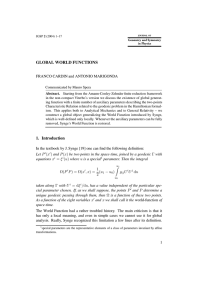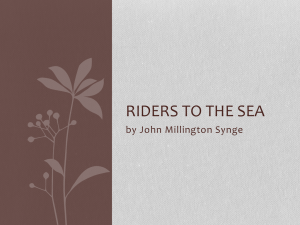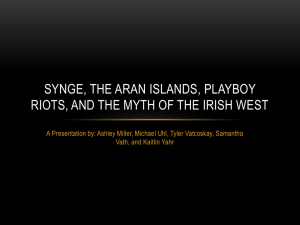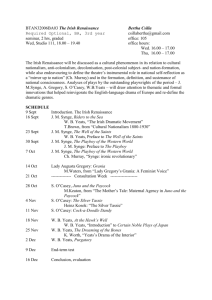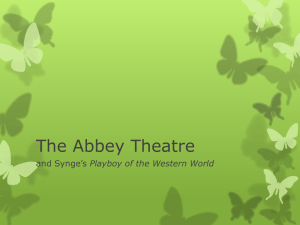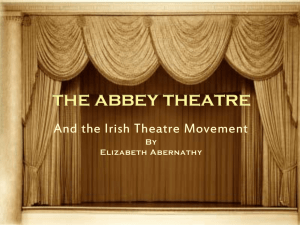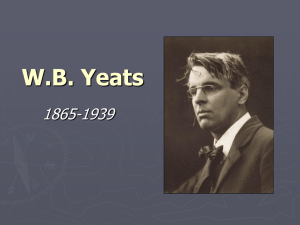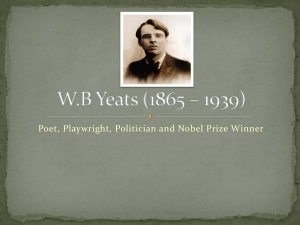riders-to-the-sea
advertisement
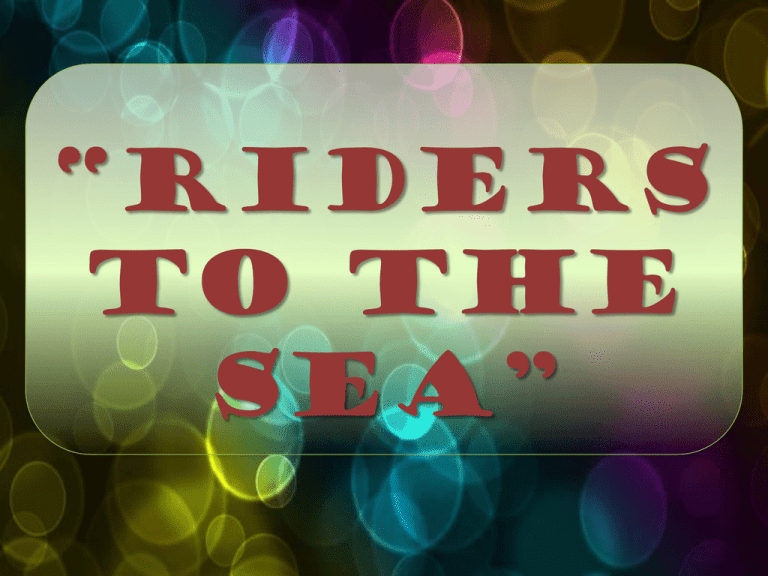
“RIDERS TO THE SEA” AT A GLANCE: • Author: J. M. Synge • First Published: Molesworth Hall, Dublin –February 25, 1904 • Type of Work: Play in one act • Type of Plot: Tragedy • Time of Work: The late nineteenth and early twentieth centuries • Setting: An island off the western coast of Ireland • Genres: Drama, Tragedy • Subjects: Sufferring, Superstition, Christianity, Paganism JOHN MILLINGTON SYNGE • Edward John Millington Synge (1871- 1909) • Irish dramatic, author and poet • John Hatch Synge (18231872) & Kathleen Traill (1838- 1908) • Hodgkin’s disease- March 24, 1909 • Cherrie Marie Louise Matheson (1870- 1940) • Much more of a listener than a talker; Synge's perfect mastery of words is one of his greatest assets. Like Shakespeare, he can at once supply environment, create atmosphere, paint word-pictures. • Synge has written that the first crisis in his faith happened when he was very young, possibly around the time his father died of smallpox. He was grasping with the concepts of eternal pain and damnation. • In 1888 he entered Trinity College, Dublin, studying Gaelic and Irish antiquities and graduated with a B.A. in 1892. These are the years he had started writing plays, inspired in part by his unrequited love of Cherie (Cherrie) Marie Louise Matheson. She couldn't possibly see herself marrying a non-believer and refused him a number of times. • Synge travelled extensively in France and Italy. Wanting to make art accessible to the common man, he formed the Irish Literary Society in 1892. In Paris, around 1896, he was to meet the poet W.B. Yeats who would become a lifelong friend and mentor. • In the shadow of the Glen; Riders to the Sea; The Playboy of the Western World; Prelude; The Aran Islands; The Well of the Saints; Deirdre of the Sorrows; The Tinkers Wedding • Before one of the operations on his neck and previously, Synge had expressed his anxieties about the fate of his manuscripts upon his death to his good friend W.B. Yeats. Yeats and Lady Gregory tried to oversee posthumous publications but there were some disputes. • "He was a drifting silent man full of hidden passion, and loved wild islands, because there, set out in the light of day, he saw what lay hidden in himself." W.B. Yeats, 1910 INTRODUCTION • Yeats advised him that he would never surpass mediocrity if he remained in Paris, so, intent on finding his writer's voice, he travelled back and forth from the continent to the rocky Aran Islands for a number of years to live with peasant seamen and their families. • It must have been on Synge's second visit to the Aran Islands that he had the experience out of which was wrought what many believe to be his greatest play. The scene of "Riders to the Sea" is laid in a cottage on Inishmaan, the middle and most interesting island of the Aran group. While Synge was on Inishmaan, the story came to him of a man whose body had been washed up on the far away coast of Donegal, and who, by reason of certain peculiarities of dress, was suspected to be from the island. In due course, he was recognized as a native of Inishmaan, in exactly the manner described in the play, and perhaps one of the most poignantly vivid passages in Synge's book on "The Aran Islands" relates the incident of his burial. • • The other element in the story which Synge introduces into the play is equally true. Many tales of "second sight" are to be heard among Celtic races. In fact, they are so common as to arouse little or no wonder in the minds of the people. It is just such a tale, which there seems no valid reason for doubting, that Synge heard, and that gave the title, "Riders to the Sea", to his play. • There is a wonderful beauty of speech in the words of every character, wherein the latent power of suggestion is almost unlimited. In the quavering rhythm of the words, there is poignantly present that quality of strangeness and remoteness in beauty which, as we are coming to realize, is the touchstone of Celtic literary art. However, the very asceticism of the play has begotten a corresponding power which lifts Synge's work far out of the current of the Irish literary revival, and sets it high in a timeless atmosphere of universal action. • • • • • OTHER INFORMATIONS Published as a flip book (one side in English, the other in French, under the title À MER À CHEVAL Celtic art - was developed in S Germany and E France by tribal artisans of the mid- to late 5th cent. Although some classical influence was evident in Celtic work, most of the complex, linear, highly ornamented pieces that survive reveal an inspiration of great originality and power. Stylized and fantastic plant and animal forms, as well as strong, geometrical, intertwining patterns, decorated the surfaces of household and ritual vessels, weapons, and body ornaments. Irish literary renaissance- late 19th- and early 20th-century movement that aimed at reviving ancient Irish folklore, legends, and traditions in new literary works. The movement, also called the Celtic renaissance, was in part the cultural aspect of a political movement that was concerned with self-government for Ireland and discovering a literary past that would be relevant to the struggle for independence. Symbolism of Celtic design in literary- The visual vocabulary of Celtic design expresses many messages. Those who are attracted to these symbols and designs in modern times and who choose to use the motifs of ancient times in today's world are often frustrated by an apparent lack of reliable information about their meanings. THEME: TRAGEDY comes w/ FAITH • Tragedy- loss, pain, suffering, death, problems, test, dilemmas and the like. • This play sum up the essence of the constant struggle of the islander against their enemy, the sea. In human context, each and everyone of us have different struggles and dilemmas to face. However, these things will not be given to us by God if he knows that we can’t surpass it. • “No man at all can be living forever, and we must be satisfied.” -Life is neither mine nor yours. It was just borrowed from God. We are all destined to die but, however, be contented and satisfied on what we have now in present, we can predict but we can never tell what will happen next. Let’s put our faith to God. He planned everything, more than that of what we need, desire and expect. Tragedies are just test. A Test of faith and love. CHARACTERS • MAURYA- an old peasant woman. She has reared six sons, four of whom are known to be dead, as are her husband and her husband’s father • BARTLEY- her son • CATHLEEN- her daughter • NORA- a younger daughter • YOUNG PRIEST • MEN AND WOMEN (mentioned only) • STEPHEN AND SHAWN- lost in the great wind; found after the bay of Gregory • SHEAMUS, HIS FATHER AND HIS OWN FATHER- lost in a dark night; no signs found • PATCH- drowned • MICHAEL- 9 days on the sea and the wind blowing SYNOPSIS OF THE PLAY AFTER nine days of constant grieving for her missing son, Michael, who, she feels certain, has been drowned, old Maurya has fallen into a fitful sleep. Her daughter, Cathleen, is busy with household tasks, when another daughter, Nora, slips quietly into the kitchen with a bundle given her by the young priest. It contains part of the clothes taken from the body of a drowned man far in the north. They have been sent to Maurya's cottage with a view to possible identification. As Maurya shows signs of waking, the girls hide the bundle until sometime when they shall be alone. Maurya's grieving for Michael is now coupled with fear of losing Bartley, her only remaining son. Five sons and a husband she has already lost to the sea. Will that insatiable tyrant insist on taking her sixth. The priest says not. But now Bartley insists that he will cross to the mainland this very day, in spite of winds and high seas, to dispose of a horse at the fair. In a fit of pique at this only remaining son for not listening to her pleas, Maurya let him go without her blessing. The girls persuade her to intercept him with the lunch they had forgotten to give him and so to make opportunity for that blessing a mother should have given. While Maurya is gone the girls open the package. The clothes are, indeed, Michael's. Their only comfort is the thought that his body has been given a good Christian burial there in the north where it was washed up. At this point Maurya returns terrified with a vision she had had of Michael riding on the red horse behind Bartley. Now she is sure Bartley is doomed. When the girls show her Michael's clothes her only response is that the good white boards she had bought for his coffin would serve for Bartley instead. • Even as she speaks, the neighboring women troop in, their voices raised in the "keen," that monotonous Irish chant of grief. Men follow bringing the body of Bartley who has been knocked off a cliff into the surf by the horse he was leading. The play closes on the note of Maurya's fatalistic submission. She can sleep now with no worry but that of starvation. "They're all gone now and there isn't anything more the sea can do to me. . . . No man at all can be living forever and we must be satisfied." INTERPRETATION in GENERAL • In real scenario, we will be experiencing these kind of things- the loss, pain, suffering and death but, let’s look the world in a wider perspective. These things will serve as our opportunities and chances to give us our own battle and be the hero. • For some point, this play is more realistic and painful rather than a dramatic story. Grief never seems to disappear in just a snap of your finger. It takes time; we should be hard as rock, with God at the center , so that we can move on with our life and accept truths and realities with an open heart and mind. VIEW POINTS: • What are Nora and Cathleen talking about at the beginning of the play? How does it affect Maurya, their mother? • What purpose do the nails, the white board, and the ropes have for Bartley at the beginning and the end of the narrative? • How is Maurya represented in this drama? What makes her a tragic figure? • Why does Maurya not allow Bartley to go to the Galway Fair? What is her premonition about this? • Why is the play called “Riders to the Sea”? • How is the sea presented in the play? In what way does it determine the fate of the characters in this dramatic piece? • Explain “No man at all can be living forever and we must be satisfied” in relation to Maurya’s reaction over the death of all her sons and husband. RESOURCES • http://www.youtube.com/watch?v=O7rGs7px5Ok • http://www.youtube.com/watch?v=W885YFe93SI • http://www.youtube.com/watch?v=E_gGFRvMZq8&p=C39D49CBC FE80EC3&playnext=1&index=7 • http://www.youtube.com/watch?v=yw63m1ukRdQ • http://www.youtube.com/watch?v=ZSZe1EIo7NE • http://www.online-literature.com/synge/riders-to-the-sea/ • http://www.one-act-plays.com/dramas/riders_to_the_sea.html • http://www.imdb.com/title/tt0425404/ • http://www.enotes.com/riders-sea-salem/riders-sea

